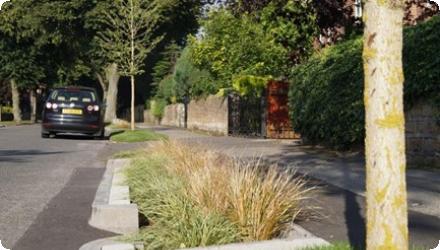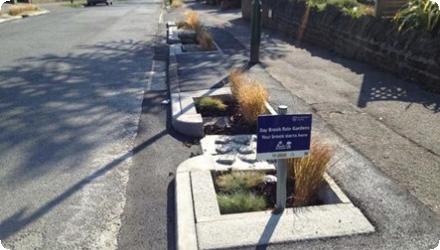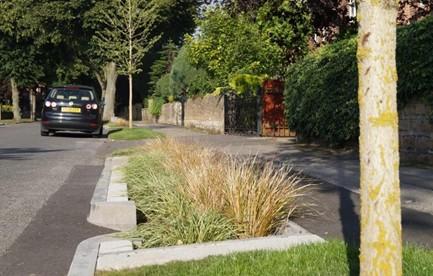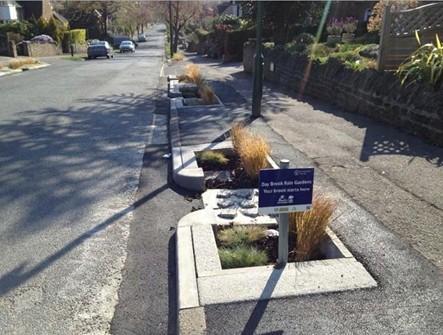Last update
2025
Summary
A rain garden was installed along the verges of a residential road in Nottingham, England. The purpose of the rain garden was to control the rate of runoff and water quality reaching the downstream watercourse (Day Brook).
A total of 21 linear rain gardens were constructed within the grass verge of Ribblesdale Road, to manage surface water run off within the catchment of Day Brook. Water contained within the gardens soaks away rather than entering the local surface water sewer which flows to the Day Brook. Construction was completed in May 2013.
The Nottingham rain gardens reduced surface water runoff by up to 30%. They help lower local flood risk, reduce combined sewer overflow, and improve water quality through filtration. Over 150 rain gardens were installed, enhancing biodiversity, creating attractive green space, and supporting pollinators. Maintenance costs are low and community feedback has been positive. The project also contributes to climate resilience and urban cooling.
A total of 21 linear rain gardens were constructed within the grass verge of Ribblesdale Road, to manage surface water run off within the catchment of Day Brook. Water contained within the gardens soaks away rather than entering the local surface water sewer which flows to the Day Brook. Construction was completed in May 2013.
The Nottingham rain gardens reduced surface water runoff by up to 30%. They help lower local flood risk, reduce combined sewer overflow, and improve water quality through filtration. Over 150 rain gardens were installed, enhancing biodiversity, creating attractive green space, and supporting pollinators. Maintenance costs are low and community feedback has been positive. The project also contributes to climate resilience and urban cooling.
Position
Latitude
52.992004
Longitude
-1.142012
Project
NWRM
National Id
United Kingdom_04
Installation date
2013
Implementation Status
Contact
Heather Williams and Katie Hill, AMEC
RBD code
UK04
Transboundary
0
Photo gallery
Location of the project
The case study is located in a central part of the United Kingdom, in Nottingham city. It is in a heavily urbanised area, at an altitude of approximately 50m AOD.
NUTS Code
UKF1 - Derbyshire and Nottinghamshire
Project's objectives
Document/assess rain-garden retrofit in a live highway.
Maximise interception, attenuation, infiltration of ~5,500 m² highway runoff.
Manage 1:30-year events; treat first flush.
Reduce sewer peaks (~33% in 1-year storm, modelled).
Engage residents; enable ongoing evaluation (data logger).
Maximise interception, attenuation, infiltration of ~5,500 m² highway runoff.
Manage 1:30-year events; treat first flush.
Reduce sewer peaks (~33% in 1-year storm, modelled).
Engage residents; enable ongoing evaluation (data logger).
Involved Partners
| Authority type | Authority name | Role | Comments |
|---|---|---|---|
Climate zone
cool temperate moist
Temperature
10.1 °C
Annual rainfall range
600 - 900 mm
Imperviousness range
> 80%
Elevation range
57 m
Slope range
1-2%
Soil type
Gleysol
Vegetation class
Local streetscape: amenity grass verges with mature street trees; rain gardens planted with Stipa (Anemanthele), Carex ‘Evergold’, Miscanthus ‘Yakushima Dwarf’, Festuca ‘Blue Fox’. Along the Day Brook corridor nearby, meadows/ponds/wetland habitats were created in Valley Road Park.
Water bodies: Ecological Status
Moderate
Water bodies: Chemical Status
Good
Water quality status
There was poor water quality within Day Brook, due in part to numerous sources of diffuse pollution from an extensive urban catchment.
Project scale
Micro
Project scale specification
Site-specific retrofit on a single residential street (Ribblesdale Road) treating ~5,500 m² of highway runoff via 21 rain gardens (148 m²).
Performance timescale
Immediate
Project area
0.55
Area specifications
The catchment area of the rain gardens is 0.55 ha
Size
148
Size unit
m2
Lifespan
Geotextile materials have an expected lifetime of over 100 years, therefore lifetime will be dependent on the filter performance and maintenance, which will be monitored over the coming years.
The primary principle was to ensure effectiveness in managing downstream water quality and flooding. As part of this, aesthetic benefits were an important consideration, to ensure no loss of the green areas already limited within the urban environment. Part of the purpose of this pilot study was to understand the public perception and acceptability of rain gardens.
The scheme was designed to manage surface water runoff from a 1:30 year event
Design capacity description
A total of 21 linear rain gardens with a total volume capacity estimatly 15m3, designed to capture runoff from 0.55 ha of highway.
The available space on the grass verges and budget available were key considerations in the selection of Rain Gardens over other schemes considered such as tree pits or permeable paving. Groundwork undertook a scoping/ feasibility study to consider the options but there is no available documented information.
The original plan for this scheme was to collect runoff from a surface area of 7100 m2, however only 5500m2 was incorporated into the scheme due to restrictions from underground services and a number of mature trees clustered in one section of Ribblesdale Road.
Proprietary water attenuation cells were key to the initial design as they provide significantly higher void space capacity than clean stone. However, budget contraints meant that use of proprietary cells was reduced and replaced by stone fill in a number of gardens.
The original plan for this scheme was to collect runoff from a surface area of 7100 m2, however only 5500m2 was incorporated into the scheme due to restrictions from underground services and a number of mature trees clustered in one section of Ribblesdale Road.
Proprietary water attenuation cells were key to the initial design as they provide significantly higher void space capacity than clean stone. However, budget contraints meant that use of proprietary cells was reduced and replaced by stone fill in a number of gardens.
The availability of the existing grass verge with occasional mature trees along the entire length of the road, allowed the effective implementation and operation of the rain gardens.
Positive influence effectiveness
The availability of the existing grass verge with occasional mature trees along the entire length of the road, allowed the effective implementation and operation of the rain gardens.
Negative influence effectiveness
Existing trees and underground services did not allow implementation along the full length of the road.
Total cost
£68,000
Costs land acquisition information
No land aquisition.
Costs operation maintenance information
There are maintenance costs accociated with the scheme, but anticipated to be less than the original maintenance costs of the grass verges.
Costs maintenance information
Maintenance is now undertaken by Nottingham City Council.
NWRM measures were designed to be minimal maintenance. To ensure fully operational inlets will occasionally need to be cleared and vegetaion maintained.
NWRM measures were designed to be minimal maintenance. To ensure fully operational inlets will occasionally need to be cleared and vegetaion maintained.
Financing authorities
Type of funding
National funds
Type of funding
Local funds
Compensations
0
Policy context
Within the highly urbanised area of Nottingham City, a total of 972 properties fall within the Day Brook floodplain, with previous fluvial events leading to property flooding downstream. Ribblesdale Road is parallel to some of the upper reaches of Day Brook, a heavily modified watercourse that has poor water quality due in part to numerous sources of diffuse pollution from the extensive urban catchment. A pilot study was implemented that reduced the volume of surface water flowing to urban drainage systems from the existing highway setting, reducing the volume of surface water flowing to urban watercourses.
Land ownership
Highway verge of an adopted public road; owned/managed by Nottingham City Council as the Local Highway Authority. Ongoing maintenance by NCC Street Cleansing.
Community involvment
Yes
Design consultation activity
| Activity stage | Name | Key issues | Comments |
|---|---|---|---|
|
Design phase
|
Local residents involvment in design
|
Participation from local residents in the design and future management of the rain gardens.
|
|
|
Other
|
Follow up survey
|
Post implimentation survey
|
Policy target
| Target purpose |
|---|
|
Runoff control
|
|
Peak-flow reduction
|
|
Increase Water Storage
|
Target Remarks
The primary aim was to prove that a retro fitting project can work within an urban environment and that rain gardens can be effective in managing surface water from public highways.
Policy pressure
| Pressure directive | Relevant pressure |
|---|---|
|
WFD identified pressure
|
Diffuse - Urban runoff - Storm overflows and discharges in urbanized areas not identified as point sources
|
|
Floods Directive identified pressure
|
Natural Exceedence - Flooding of land by waters exceeding the capacity of their carrying channel or the level of adjacent lands.
|
Policy impact
| Impact directive | Relevant impact |
|---|---|
|
Other non-EU
|
Property - Adverse consequences to property and businesses.
|
|
WFD identified impact
|
Waterbody Status - Adverse consequences to ecological or chemical status of surface water bodies as of concern under the WFD.
|
Requirement directive
| Requirement directive | Specification |
|---|---|
|
Floods Directive-mitigating Flood Risk
|
Address risk of flooding to local and downstream properties.
|
|
WFD-mitigation of significant pressure
|
Address effects of diffuse pollution from urban catchment.
|
Policy challenges requirements
Urban diffuse pollution programme across the region
Contractual arrangements
0
| Arrangement type | Responsibility | Role | Name | Comments |
|---|
Part of wider plan
0
Wider plan type
| Wider plan type | Wider plan focus | Name | Comments |
|---|
A data logger was installed beneath two of the rain gardens, which allows continuous water depth recording. This monitoring has taken place between May 2013 and September 2014.
Maintenance
Maintenance is undertaken by Nottingham City Council. Annual trim of vegetation, occasional mulching and clearing of the inlet.
Laboratory
Continuous water level monitoring is allowing a short period of data to be collected post-implementation, and will allow future monitoring of any variation in rain garden performance.
InfoWorks CS 2D modelling has been undertaken since implementation, to model the anticipated reduction in the flow reaching the sewer based on the data logger information.
InfoWorks CS 2D modelling has been undertaken since implementation, to model the anticipated reduction in the flow reaching the sewer based on the data logger information.
A Survey was undertaken of local residents following implementation to understand opinions and acceptance of rain gardens since construction.
The use of rain gardens in a predominantly urban landscape provides a cost effective and adaptable means to reduce flood risk, while providing aesthetic value to highly populated area.
Hydrological effects
The rain gardens reduce surface runoff, enhance infiltration, support groundwater recharge, and increase evapotranspiration. They slow flow, store water temporarily, and lessen sewer overflow and flood risks.
Information on retained water
Verified capture/infiltration and reduced downstream load; ~33% reduction in flow to sewer for a 1-year storm (modelled); design to manage up to 1:30-year events; overflow to gullies for exceedance.
Information on increased water storage
No storage previously
Runoff reduction
33
Runoff reduction unit
% Percent
Information on runoff reduction
Increased water storage will provide additional capacity to retain and efficiently remove run off from highways, and infiltrate to ground. This will reduce the volume of water reaching the local sewer and Day Brook. Modelled 33% reduction in flow reaching the sewer for 1 in 1 year event
Information on Peak flow rate reduction
The storage capacity of the rain gardens will result in reduced peak flows reaching the local sewer, as water will be slowed and contained in the gardens.
Maintenance baseflow
0
Information on Maintenance baseflow
Possible increases to infiltration to groundwater from rain gardens, providing groundwater recharge and baseflows to the brook. However the influence is likely to be minor.
Information on Reducing flood risks, quantity
Qualitative benefits: the rain gardens provided visible reductions in standing water during storms and improved drainage response time.
Information on Ecosystem flood control volume
Reducing the volume of water reaching the Day Brook in rainfall events will reduce flood risk to downstream homes and businesses. The reduction in flows reaching the sewer will reduce risk of localised sewer flooding.
Ecosystem flood control return periods
n/a
Ecosystem erosion control
0
Water quality overall improvements
N/A info
Information on Water quality overall improvements
Rain gardens are designed to always intercept and treat the, often more polluted, first flush of highway runoff, ensuring this polluted water does not reach the Day Brook or the local sewer. However there is no available data for the quality of water flowing into or within the rain gardens.
Soil quality overall soil improvements
N/A info
1
The Landscape Institute case study notes that the planting attracted bees and insects, enhancing biodiversity in a heavily urbanised environment.
Ecosystem impact climate regulation
Not relevant for the specific application
Ecosystem provisioning services
0
Information on Ecosystem provisioning services
Unlikely to be a signficant effect
Key lessons
The purpose of this pilot study was to prove that a retrofit design would work within an existing constrained urban area and will be accepted by both residents and experts. The specific design of these rain gardens and the site layout is shown to work, and could be replicated.
Key lessons identified are that :
- The measure provides proven surface water capture and infiltration, leading to reduced pressure on the local sewer and watercourse.
- Active residents/ stakeholder engagement and involvement during design and construction helps ensure that concerns are being considered and that the scheme will be accepted and valued.
- When delivered as a collaborative project, multiple benefits can be achieved such as knowledge transfer and local involvement and understanding.
- It is important that all involved (from designers to the construction crew on the ground) are clear on what is to be achieved and how, before implementation/ construction begins.
Key lessons identified are that :
- The measure provides proven surface water capture and infiltration, leading to reduced pressure on the local sewer and watercourse.
- Active residents/ stakeholder engagement and involvement during design and construction helps ensure that concerns are being considered and that the scheme will be accepted and valued.
- When delivered as a collaborative project, multiple benefits can be achieved such as knowledge transfer and local involvement and understanding.
- It is important that all involved (from designers to the construction crew on the ground) are clear on what is to be achieved and how, before implementation/ construction begins.
Success factor(s)
| Success factor type | Success factor role | Comments | Order |
|---|---|---|---|
|
Successful coordination between authorities
|
main factor
|
<p>The partnership approach between all stakeholders was critical to the delivery of the retrofit scheme and was very effective.</p>
|
1
|
|
Communication activities
|
secondary factor
|
<p>The positive attitude of the local residents and their involvement in meetings as the project progressed ensured support.</p>
|
2
|
|
Other
|
secondary factor
|
<p>The land was already owned by the local authority so there were no land ownership issues.</p>
|
3
|
Driver
| Driver type | Driver role | Comments | Order |
|---|---|---|---|
|
Past flooding events
|
secondary driver
|
Previous rainfall events had led to property flooding downstream.
|
1
|
|
Availability of subsidies
|
main driver
|
Money available as part of wider Urban Diffuse Programme in the region
|
2
|
Flexibility adaptability
The scheme was implemented to increase the capacity to manage highway runoff, but was not specifically designed to consider climate change. However the new storage supports the existing highway drainage system to make it more resilient and effective in accommodating change.
Transferability
The approach seen with the Day Brook Catchment is suited to similar urban catchments and sites with limited space. However it should not be replicated without consideration of local factors.
Basin characteristics influence
There are no specific basin characteristics necessary for this type of measure. It could be widely applicable to urban catchments, but the detailed design would need to consider local factors.
English



